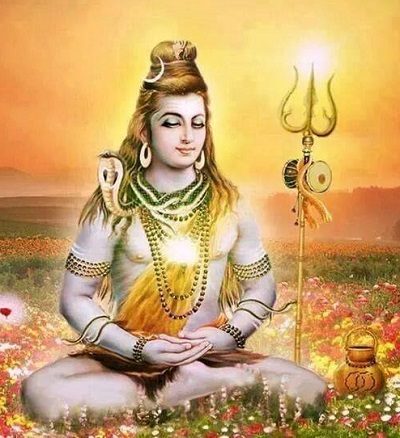The month of Shravan popularly known as the Shravan mass is believed to be one of the holiest months in the year as per the Hindu panchang (calendar). Shravan is the fifth month in the Hindu calendar. Do you know why this month known as Shravan? Well, it is called as Shravan because during this month on a full moon or a Poornima the star or the popularly known as the Shravan Nakshatra rules the skies and hence the name. Shravan is a month which is as auspicious as the festivals and pivotal events that occur in life. This is the best time or one of the most shubh samay to conduct all the important religious ceremonies. It is said to be the best time to start something new, to begin afresh or to have a good start. The ruling deity of this auspicious period, the Shravan maas’ is Lord Shiva.
Each Monday that falls in the month of Shravan is known as the Shravan Somvar and is celebrated across all India in temples and in households. Dharanatra can be seen hanging over the Shiva linga in the temples. The Shivling is given holy bath with milk, honey, water throughout the day and night. Devotees offer prayers and worship and also offer Bael leaves, flowers, holy water and milk. Apart from worshiping, praying and chanting the worshippers also fast until the sun goes down and they light a Nandadeep or the Akhand Diya that burns throughout.
Important Dates of Shravan Maas 2019:
Dates in Maharashtra, Gujarat, Goa, Karnataka, Andhra Pradesh, and Tamil Nadu
- Aug 02 (Friday, Ma as begins)
- Aug 05 (Monday)
- Aug 12 (Monday)
- Aug 19 (Monday)
- Aug 26 (Monday)
- Aug 30 (Friday, Maas ends)
Dates in Himachal Pradesh, Punjab, Rajasthan, Bihar, Uttar Pradesh, and Madhya Pradesh
- July 17 (Wednesday, Maas begins)
- July 22 (Monday)
- July 29 (Monday)
- Aug 05 (Monday)
- Aug 12 (Monday)
- Aug 15 (Thursday, Maas ends)
Swana Shivratri:
In a whole year, there are twelve Shivratris. The devotees of Lord Shiva offer prayers to the Shivling during the Shivratris and throughout the Shravan Mass. A Shivratri that falls during Shravan mass is known as the Swana Shivratri or the Shravan Shivratri. It is believed that worshipping and praying over Lord Shiva or meditating during this month gives fruitful results and also helps to attain blessings of Lord Shiva. In 2019, the Swana Shivratri falls on 30th July, Tuesday with the Nishita Kaal Puja Time from 12:23 AM to 01:07 AM (31st July). People from across the country travel to North India, Kashi Vishwanath and Badrinath Dham and visit the Shiva temples where they perform special Pujas dedicated to Lord Shiva. This is the best time to worship Shiva. On this Shravan Shivratri, people also perform Gangajal Abhishek in order to honour the holy waters of Ganges.
Significance of Shravan Maas:
The significance of Shravan Month is mentioned in many ancient Holy Scriptures as the most holy month. During this period devotees observe fasts, offer prayers and perform austerities, to appease Lord Shiva. According to the Holy Scriptures, the Shravan Mass is the time when Lord Shiva consumed the Halahala, a dreadful poison that emerged during the churning of the milky ocean, popularly known as the Samudra Manthan. During the churning, a lot of valuables such as gemstones, Goddesses, riches, cows, bows, the Moon, conch etc. emerged which were taken up by gods and demons. Also during the churning fourteen different gems emerged from the ocean which was again divided between the gods and the demi gods. When the Ocean produced the deadliest poison called Halahala, all of them cringed back as it was too dangerous and had the power to destroy the universes. It was then, when Lord Shiva came into the picture and decided to consume the poison in order to save the world. Goddess Parvati wife of Lord Shiva saw Him consuming the Halahala, she at once held His throat in order to stop the poison from spreading in other parts of His body. As a result His throat turned blue and He was called Neelkantha.
Things to do in Shravan Maas:
Since Shravan Mass is highly auspicious as per Vedas, you can engage in activities that add to your devotion to Shiva.
- Rudra Abhishek And Homa
- Mantra Chanting
- Daily worship and prayers
- Avoid eating meat and fish
- Observe fast
Ways to Fast during Shravan Mass
In the holy ancient scripture, the Shiv Purana it is mentioned how to fast during Shravan Maas. According to Shiva Purana, devotees who observe fast during the month of Shravan are blessed with the grace of Lord Shiva and their desires are fulfilled.
There are two ways of observing the fast:
- Austere Fast:When a person undertakes Austere Fasting
He/she does not consume anything except for drinking water for an entire day. The devotee than breaks the fast after sunset and consumes food that does not have onion and garlic in it.
- Partial fast:In this type of fasting, an individual is permitted to consume fruits and foods like sabudana and like once in the day and one meal in the night. The fast is broken after sunset, some devotees however, continue fasting till next day by just consuming food once in the entire day. The fast is generally broken by offering prayers to Lord Shiva post which normal food is consumed.
- One more interesting type of fasting is to observe a maun vrat (Silence) for one whole day in this month and meditate over Lord Shiva in your mind.
Things to avoid eating during Shravan Mass:
- Avoid table salt, instead make use of black salt
- Avoid consuming meat, fish, chicken
- Avoid consuming garlic, onion, brinjal and leafy vegetables during this entire month.
Benefits of Fasting on Mondays in Shravan Maas:
- Devotees are uplifted spiritually
- It helps to improve physical and mental health
- Offers aharp memory and increased willpower
- Women who fast on Shravan Mondays (Somvars) get a perfect life partner
- It dispels negativity and removes obstacles that are hindering growth and success in life.


